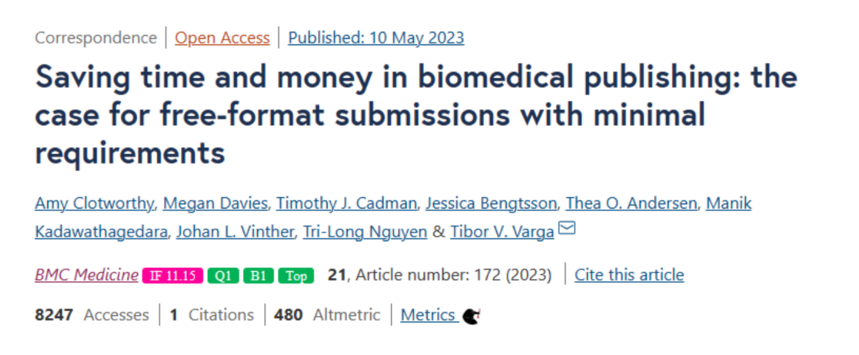Please click the button below to go to our email login page
|
Being rejected and resubmitted repeatedly & Revising format repeatedly! What a waste of time and money!Science researchers are often troubled with revision of manuscript format during submission to various journals. To meet the demands of target journal’s guideline, authors tend to spend several hours. However, once in the rejection state, the format should be revised again for resubmission to other journals. A recent analysis report issued in BMC Medicine puts a price tag on this energy- and time-consuming work, based on which only in 2021, the worldwide science researchers have wasted $230 million worth of time revising manuscript format. Hence, authors suggested journals should allow free-format submission, so that more time and money can be spent on research.
1. Different guidelines among journals It’s mainly the inconsistencies between journals’ guidelines that force researchers to reformat and sometimes rewrite their manuscripts, says Laura Hilton, a cancer genomics scientist at BC Cancer, a care center in Vancouver, Canada. For example, some journals require graphic abstract, while others don’t; some require results and conclusion to be placed together, while others require them to be separated. Also, different journals have distinct requirement in terms of the number of characters in the full title, the word count of abstract, the number of references, etc.
To have a preliminary knowledge on the cost of reformatting, Tibor Varga, an epidemiologist at the University of Copenhagen and his colleagues estimated average hourly academic salaries in the United States and the European Union, the time spent reformatting per manuscript and the annual number of resubmissions. They calculated that, if current journal practices don’t change, reformatting could cost about $2.5 billion worth of time of researchers between 2022 and 2030.
2. Compromised proposal Some researchers proposed to use same guidelines for all journals or allow free-format submission. Based on the review of over 300 kinds of journals’ guidelines, as well as the interview of science researchers and journal editors, the author recommends a compromised solution, which allows researchers to submit without following specific formatting requirements, but complying with minimum requirements, such as total word count.
Researchers interviewed by Nature say that they don’t mind to revise the format according to journals’ requirements, but this work should be started after the manuscript is confirmed to be accepted. Co-author Amy Clotworthy, an ethnologist at the University of Copenhagen, says that the authors focus mainly on biomedical journals because these tend to have a specific format that is different from, for example, that of social-sciences publications. However, the suggestion about free-format submission is applicable to other disciplines as well. 3. Unsustainable submission pattern of journals Christine Laine, editor-in-chief of Annals of Internal Medicine says that, given thousands of journals with different “audiences and personalities”, it’s “often appropriate” for journals to have different submission guidelines for word count and other aspects of a paper. Magdalena Skipper, editor-in-chief of Nature, says that the initial format of a submission to the journal “does not influence consideration of acceptance or not.” Varga acknowledges that some journals relatively loosen the format requirement for submission, but most journals remain strict. In the long run, researchers will not put up with practices that greatly inconvenience them, and “the current submission pattern is unsustainable”, Varga says. |




